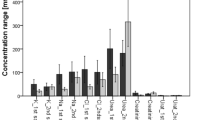Abstract
The most important of nature of biomarker is changes. Blood is under strict homeostatic control which means changes tend to be removed from blood. Urine is a partial filtrate of blood, reflects systemic physiology but with no homeostatic mechanism. However, changes induced directly into the blood can be more sensitively detected in urine than in blood itself. This indicates that urine may serve as a source for more sensitive detection of protein biomarkers than blood.
Access this chapter
Tax calculation will be finalised at checkout
Purchases are for personal use only
Similar content being viewed by others
References
Gao YH (2013) Can urine be the gold mine for biomarker discovery? Sci China Life Sci 56
Decramer S, Gonzalez de Peredo A, Breuil B et al (2008) Urine in clinical proteomics. Mol Cell Proteomics 7:1850–1862
Yi J, Kim C, Gelfand CA (2007) Inhibition of intrinsic proteolytic activities moderates preanalytical variability and instability of human plasma. J Proteome Res 6:1768–1781
Schaub S, Wilkins J, Weiler T et al (2004) Urine protein profiling with surface-enhanced laser-desorption/ionization time-of-flight mass spectrometry. Kidney Int 65:323–332
Menglin L, Mindi Z, Youhe G (2013) Changes of proteins induced by anticoagulants can be more sensitively detected in urine rather than plasma. Sci China Life Sci 57(7):649–656
Thongboonkerd V, McLeish KR, Arthur JM, Klein JB (2002) Proteomic analysis of normal human urinary proteins isolated by acetone precipitation or ultracentrifugation. Kidney Int 62:1461–1469
Brunzel N (2004) Fundamentals of urine & body fluid analysis, 2nd edn. Saunders, Philadelphia
Pieper R, Gatlin CL, Makusky AJ, Russo PS, Schatz CR, et al (2003) The human serum proteome: display of nearly 3700 chromatographically separated protein spots on two-dimensional electrophoresis gels and identification of 325 distinct proteins. Proteomics 3:1345–1364
Nagaraj N, Mann M (2011) Quantitative analysis of the intra- and inter-individual variability of the normal urinary proteome. J Proteome Res 10:637–645
Adkins JN, Varnum SM, Auberry KJ, Moore RJ, Angell NH et al (2002) Toward a human blood serum proteome: analysis by multidimensional separation coupled with mass spectrometry. Mol Cell Proteomics 1:947–955
Mehta AI, Ross S, Lowenthal MS, Fusaro V, Fishman DA et al (2003) Biomarker amplification by serum carrier protein binding. Dis Markers 19:1–10
Kentsis A, Monigatti F, Dorff K, Campagne F, Bachur R et al (2009) Urine proteomics for profiling of human disease using high accuracy mass spectrometry. Proteomics Clin Appl 3:1052–1061
Halim A, Nilsson J, Rüetschi U, Hesse C, Larson G (2012) Human urinary glycoproteomics; attachment site specific analysis of N- and O-linked glycosylations by CID and ECD. Mol Cell Proteomics 11
Khadjavi A, Barbero G, Destefanis P, Mandili G, Giribaldi G et al (2011) Evidence of abnormal tyrosine phosphorylated proteins in the urine of patients with bladder cancer: the road toward a new diagnostic tool? J Urol 185:1922–1929
McDonald WH, Yates JR, 3rd (2002) Shotgun proteomics and biomarker discovery. Dis Markers 18:99–105
Chen T, Xie G, Wang X, Fan J, Qiu Y et al (2011) Serum and urine metabolite profiling reveals potential biomarkers of human hepatocellular carcinoma. Mol Cell Proteomics 10:M110 004945
Wu T, Du Y, Han J, Singh S, Xie C et al (2013) Urinary angiostatin—a novel putative marker of renal pathology chronicity in lupus nephritis. Mol Cell Proteomics 12:1170–1179
Pories SE, Zurakowski D, Roy R, Lamb CC, Raza S et al (2008) Urinary metalloproteinases: noninvasive biomarkers for breast cancer risk assessment. Cancer Epidemiol Biomarkers Prev 17:1034–1042
Huang JT, Chaudhuri R, Albarbarawi O, Barton A, Grierson C et al (2012) Clinical validity of plasma and urinary desmosine as biomarkers for chronic obstructive pulmonary disease. Thorax 67:502–508
Thomas CE, Sexton W, Benson K, Sutphen R, Koomen J (2010) Urine collection and processing for protein biomarker discovery and quantification. Cancer Epidemiology Biomarkers & Prevention 19:953–959
Weissinger EM, Wittke S, Kaiser T, Haller H, Bartel S et al (2004) Proteomic patterns established with capillary electrophoresis and mass spectrometry for diagnostic purposes. Kidney Int 65:2426–2434
Jantos-Siwy J, Schiffer E, Brand K, Schumann G, Rossing K et al (2009) Quantitative urinary proteome analysis for biomarker evaluation in chronic kidney disease. J Proteome Res 8:268–281
Lankisch P, Wessalowski R, Maisonneuve P, Haghgu M, Hermsen D et al (2006) Serum cystatin C is a suitable marker for routine monitoring of renal function in pediatric cancer patients, especially of very young age. Pediatr Blood Cancer 46:767–772
Lemm G, Kuppers J, Frey R, Wingender W, Kuhlmann J (1998) Monitoring of proteinuria in phase I studies in healthy male subjects. Eur J Clin Pharmacol 54:287-294
Author information
Authors and Affiliations
Corresponding author
Editor information
Editors and Affiliations
Rights and permissions
Copyright information
© 2015 Springer Science+Business Media Dordrecht
About this chapter
Cite this chapter
Li, M. (2015). Urine Reflection of Changes in Blood. In: Gao, Y. (eds) Urine Proteomics in Kidney Disease Biomarker Discovery. Advances in Experimental Medicine and Biology, vol 845. Springer, Dordrecht. https://doi.org/10.1007/978-94-017-9523-4_2
Download citation
DOI: https://doi.org/10.1007/978-94-017-9523-4_2
Published:
Publisher Name: Springer, Dordrecht
Print ISBN: 978-94-017-9522-7
Online ISBN: 978-94-017-9523-4
eBook Packages: Biomedical and Life SciencesBiomedical and Life Sciences (R0)




